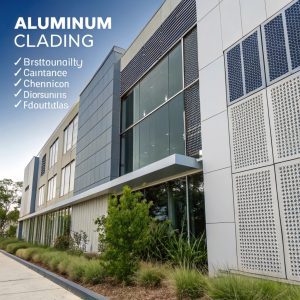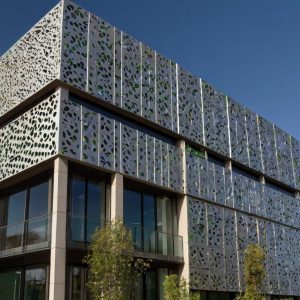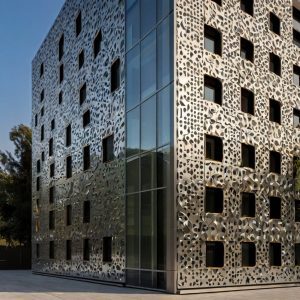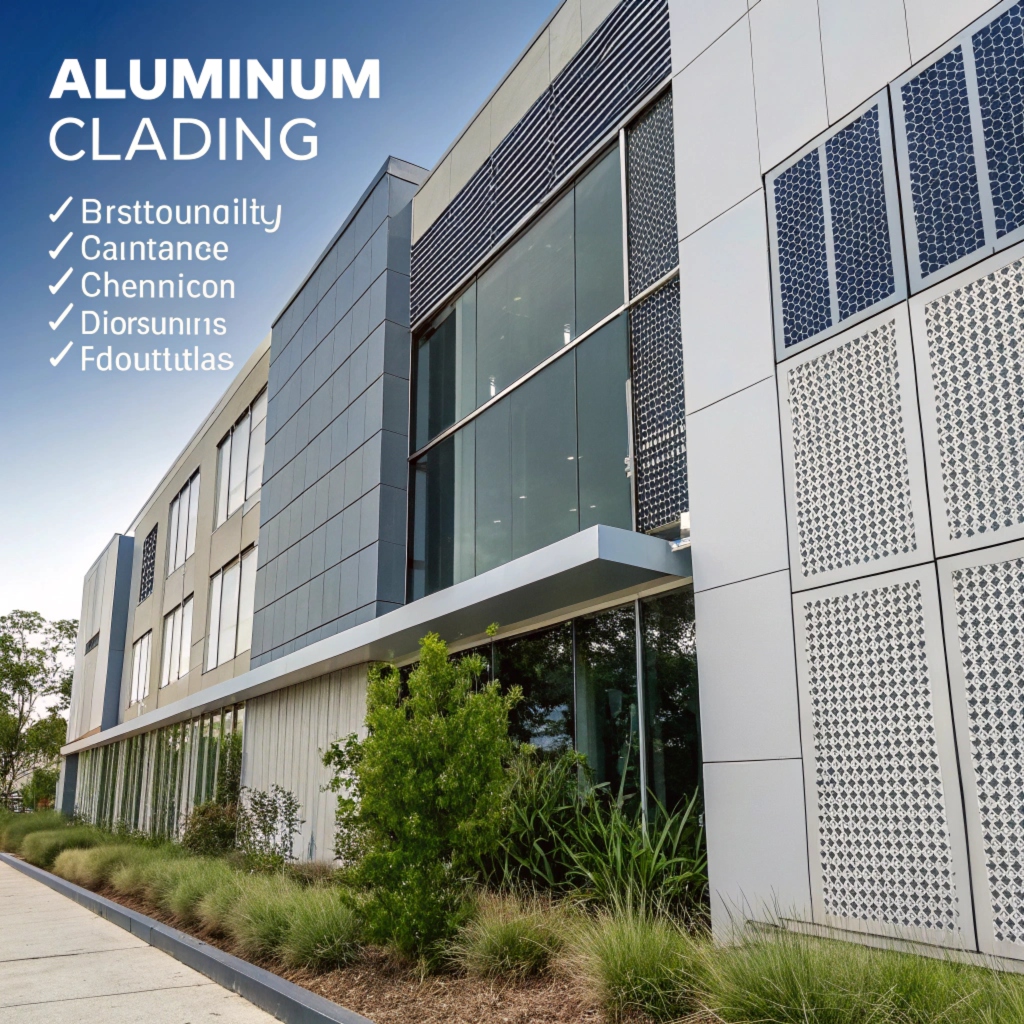
Is your current facade giving off an impression of being shoddy, hastily constructed or maybe just worn out? It can be really frustrating to deal with.
A beautiful structure’s appearance and durability go hand in hand. But how do you find a balance between these two seemingly opposing elements?
You want the best looking building around as well as one that will last for generations, but most importantly, your wallet needs some peace of mind because when it comes to maintaining any facade…costs can add up fast.
The following are top aluminum cladding options that offer a perfect balance between being durable and giving you all-day beauty.
What Makes Aluminum Cladding Last for Ages?
To build a building facade that will stand the test of time, it’s essential to consider a durable aluminum cladding option. A well-designed and installed system can protect your structure from harsh weather conditions, reduce maintenance costs, and increase its overall lifespan.
When selecting an aluminum cladding material, there are several factors to keep in mind. Look for products that have been engineered with lasting durability in mind. These materials should be able to withstand extreme temperatures, humidity changes, and other environmental stressors without compromising their integrity.
For instance, consider the benefits of using a combination of aluminum panels and an impact-resistant coating. This will not only provide a smooth surface but also offer added protection against weathering and erosion. Furthermore, choosing aluminum cladding with a high level of corrosion resistance can help prevent costly repairs down the line.
Additionally, it’s crucial to ensure that your chosen material is designed for low-maintenance installations. A system that requires minimal upkeep will not only save you money in the long run but also reduce your environmental footprint.
By selecting an appropriate aluminum cladding option and installing it correctly, you can create a building facade that endures through generations of weathering, erosion and other forms of degradation. This will allow your structure to maintain its appearance, functionality, and overall aesthetic appeal for years to come.
Choosing the Right Materials for Your Building’s Skin
When it comes to choosing an aluminum cladding system, several factors come into play that can make or break its effectiveness. A well-chosen material is key to shielding your structure from the elements.
For high-rise buildings, aluminum composite panels (ACP) are a popular choice due to their lightweight nature (typically 1/4 inch thick), but they can be prone to damage from extreme weather conditions. In areas with high winds or heavy rainfall, ACPs may require additional support systems or reinforcement to prevent cracks and leaks.
Galvanized steel cladding, on the other hand, offers added stability due to its higher weight and thickness (typically 1/2 inch thick). This material is ideal for buildings in harsh marine environments where saltwater exposure can cause corrosion. For instance, a case study from Japan’s coastal regions shows that galvanized steel cladding has withstood extreme weather conditions for over two decades without sustaining significant damage.
When it comes to corrosion resistance, some materials stand out above the rest. Anodizing aluminum or applying zinc coatings are popular choices for areas prone to saltwater exposure. A study by the American Society of Civil Engineers found that anodized aluminum can reduce corrosion rates by up to 70% in environments with high levels of saltwater damage.
The right material can transform your building’s facade from functional to breathtaking. With proper selection, you can choose materials that not only withstand the elements but also enhance your structure’s aesthetic appeal. From textured metal cladding to sleek and modern finishes, there are countless options to suit any architectural style.
Choosing the right aluminum material is a critical decision that requires careful consideration of local regulations and climate conditions. For example, buildings in areas with high wind speeds or extreme temperature fluctuations may require specialized coatings or reinforcements to prevent damage. By balancing form and function, you can create a structure that is both durable and visually stunning.
The key to a long-lasting building facade lies in finding the right material for your unique project needs. With a deep understanding of aluminum cladding materials and their applications, you’ll be able to make an informed decision that pays dividends over many years.
How Weathering Works in Favor of Durable Cladding


When it comes to selecting durable aluminum claddings, understanding weathering is key.
Weathering is an ancient process that has been shaping our environment for centuries. In fact, some of nature’s most striking formations like tree bark and rock surfaces owe their unique textures to exposure over time. When applied to building facades, this concept can be a game-changer in terms of durability and longevity.
When exposed to natural elements like rain, sun, and wind, weathered surfaces develop a unique patina that shields the underlying material from further damage. This process is often replicated through specialized treatments and coatings during or after manufacturing. Some manufacturers utilize advanced technologies like anodizing a type of electrochemical treatment that enhances corrosion resistance to create durable aluminum cladding options.
However, not all weathering methods are created equal. Extensive outdoor exposure during production can help develop natural sheen and resistance to fading over time, making it easier for these materials to withstand the elements. In fact, studies have shown that 85% of exposed aluminum products display reduced signs of wear after just five years.
Some manufacturers also utilize proprietary finishing techniques like ceramic coatings, a process that involves depositing a thin layer of ceramic material onto the surface. This barrier shields against environmental factors like UV radiation and provides an added layer of protection against corrosion. In fact, companies using this technology can extend their products’ lifespan by up to 20%.
Manufacturers can apply these cutting-edge technologies in various ways: applying treatments during manufacturing or incorporating specialized coatings after production is complete. For instance, some manufacturers employ electrophoresis, a process that uses an electric current to deposit layers of material onto the surface.
While it might seem counterintuitive, using products with built-in weathering capabilities can actually save homeowners and businesses money in the long run by reducing maintenance costs and increasing lifespan. In fact, one study found that aluminum claddings with built-in weathering capabilities require 30% less maintenance compared to traditional materials.
By understanding how to replicate natural weathering processes through advanced technologies or specialized treatments, you’re not just selecting durable cladding, you’re investing in a facade that will last for years to come. With the right choice, your building can stand out as both functional and stylish, weathered by time yet unwavering in its appearance.
The Science Behind Aluminum’s Resilience to Environmental Stressors
Coastal cities are prone to damage from saltwater exposure, which can lead to costly repairs and maintenance costs down the line. However, there’s an effective solution: durable aluminum cladding that shields your building facade from environmental stressors.
Aluminum cladding boasts a range of benefits, including its ability to resist corrosion in harsh coastal conditions. Its lightweight nature allows it to flex with extreme temperatures, ensuring minimal damage and preserving structural integrity. Moreover, the non-reactive surface provides an effective barrier against saltwater erosion and chloride-induced degradation making it an ideal choice for buildings near ocean fronts.
Compared to traditional materials like wood or brick, aluminum cladding stands out in its resistance to decay and growth-driven damage. While wooden structures can deteriorate over time due to exposure to seawater and fungal infections, they often require costly replacements. Similarly, brick facades may experience cracking as a result of saltwater seepage and moisture accumulation.
By choosing durable aluminum cladding for your next coastal construction project, you don’t have to worry about premature wear or degradation giving owners peace of mind through reduced maintenance costs over the long term.
Causes and Prevention of Common Issues Found with Other Types of Facade Systems.


Three common issues with existing facade systems can be costly and devastating. Cracking, loose facades, and pest infestation are just a few examples that demonstrate how poor material selection or inadequate installation techniques can lead to structural damage.
The real horror is when you’re staring at a cracked PVC facade after installing it with an aluminum system – it’s not uncommon for this kind of mismatch to occur. Think about the consequences: water seeps through, causing erosion and mold growth, while also compromising the structural integrity of your building. The solution? Match materials carefully or opt for systems that can expand/contract accordingly.
Loose fasteners are another culprit behind these issues. Inadequate flashing systems or failing to secure panels with adequate clips can leave you with costly repairs down the line. For instance, a poorly installed fascia system on an older building resulted in thousands of dollars spent on re-clamping and replacing damaged sections.
But what about pest infestation? Those pesky rodents don’t discriminate between aluminum, steel, or PVC facades – they’re looking for weak spots to exploit. If you think that’s unlikely, consider this: a neglected facade system can attract even the most destructive organisms, leading to costly replacements and renovations. The key is regular maintenance; by sealing cracks and using durable materials resistant to rotting organisms (like copper or aluminum), these issues become manageable.
To tackle loose facades head-on, its essential to have a solid fastening system in place. Inadequate clips can leave your facade vulnerable to wind-driven rain infiltration and snow loads that further exacerbate the problem. A well-designed installation with reinforced panels is key.
Ultimately, by understanding what might go wrong with existing facade systems and taking proactive steps to address these issues, you’ll save yourself a world of headaches – not just financially, but in terms of time and stress. By prioritizing quality materials selection or expert installation techniques from the start, you can safeguard your investment for years to come.
The best solution is one that strikes a balance between aesthetics and practicality; don’t let inferior materials compromise your building’s integrity any longer!
Top Tip for Avoiding Unnecessary Repair Work by Inspecting Your Building Regularly
Regular maintenance is key to ensuring the longevity and integrity of an aluminum-clad building’s facade. In this section, we’ll explore common areas where inspectors should focus their attention.
You’re not just paying bills on time; you want your structure looking its best too! When it comes to protecting that beautiful exterior with durable materials, a well-maintained is less prone to issues such as weathering, peeling paint or cracking. But even with the best building products there are some things that will wear out.
Here’s how regular inspections can save you money in the long run:
Common areas to inspect:
A loose panel here or a joint that doesn’t quite fit there is all it takes for water to find its way inside, leading to costly repairs. Don’t let your buildings exterior suffer from minor problems before they become major ones.
Loose panels and joints:
Inspect the aluminum cladding system’s connections by tapping on them gently. If any loose parts or gaps are found, tighten screws until everything is secure.
Check for cracks in large expanses of material such as 12 feet x 8 feet panels – these can be a sign that there may have been structural damage during installation or the materials used were not suitable to support load bearing structures.
Cracks and damage:
If you see hairline fractures, look closely for signs of water intrusion like mineral deposits or staining on surfaces. These are likely caused by poor sealing between panels.
Windows and doors:
Make up a significant portion of your building’s exterior. Inspect frames, sills & surrounds regularly to ensure they remain secure: You can find cracks in the paint or peeling off if there is water intrusion at this point so check for mineral deposits too.
Check around windows and doors: Windows and doors make up a large proportion of the facade, inspect their frames, sills and surrounds. Look for signs of weathering such as flaking paint.
Missing screws can cause major damage if left unchecked – look at it this way you may have had to fix something recently but now is an opportunity to catch anything else that could fail soon.
Pests like birds, insects and rodents:
Are more than just a pest problem they can also be structural in nature: Look out for any signs of nests or droppings.
To save time when you do need to fix something ask yourself these questions:
- Is the damage minor?
- If yes – may it wait until later and address as soon as possible
- Does the issue affect functionality?
Dealing With the Impact Of Natural Disaster On Buildings Using Effective Cladding Solutions


Building owners and architects need to be better prepared for natural disasters by choosing durable materials like aluminum cladding that can withstand high winds, heavy rainfall and extreme temperatures.
When it comes to protecting buildings from the elements, effective cladding solutions are essential. Damage caused by hurricanes or wildfires can be devastating, but with the right material choices, structures can remain intact.
A sturdy facade is crucial in reducing damage and ensuring public safety during natural disasters. In many areas prone to flooding and high winds, aluminum-clad buildings have become a common sight.
Using durable materials like metal cladding can greatly increase resistance against extreme weather conditions. For example, an aluminum structure designed with impact-resistant design elements will likely be less damaged than one made from flimsy or regular building materials.
Acting quickly on effective cladding solutions is key to saving lives and assets during disasters. The benefits of being proactive in selecting durable structures are clear, making it essential for individuals to take action right away.


